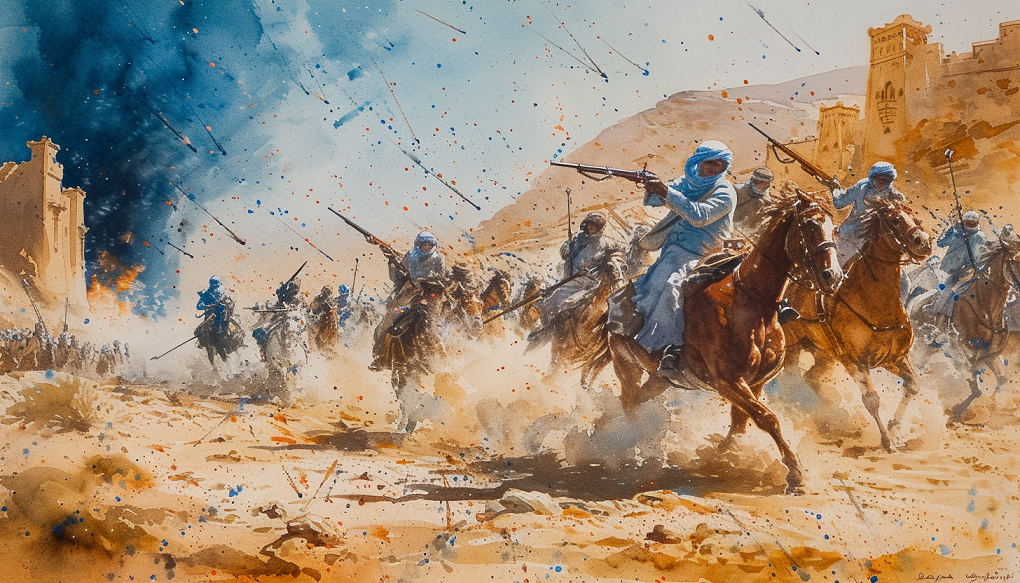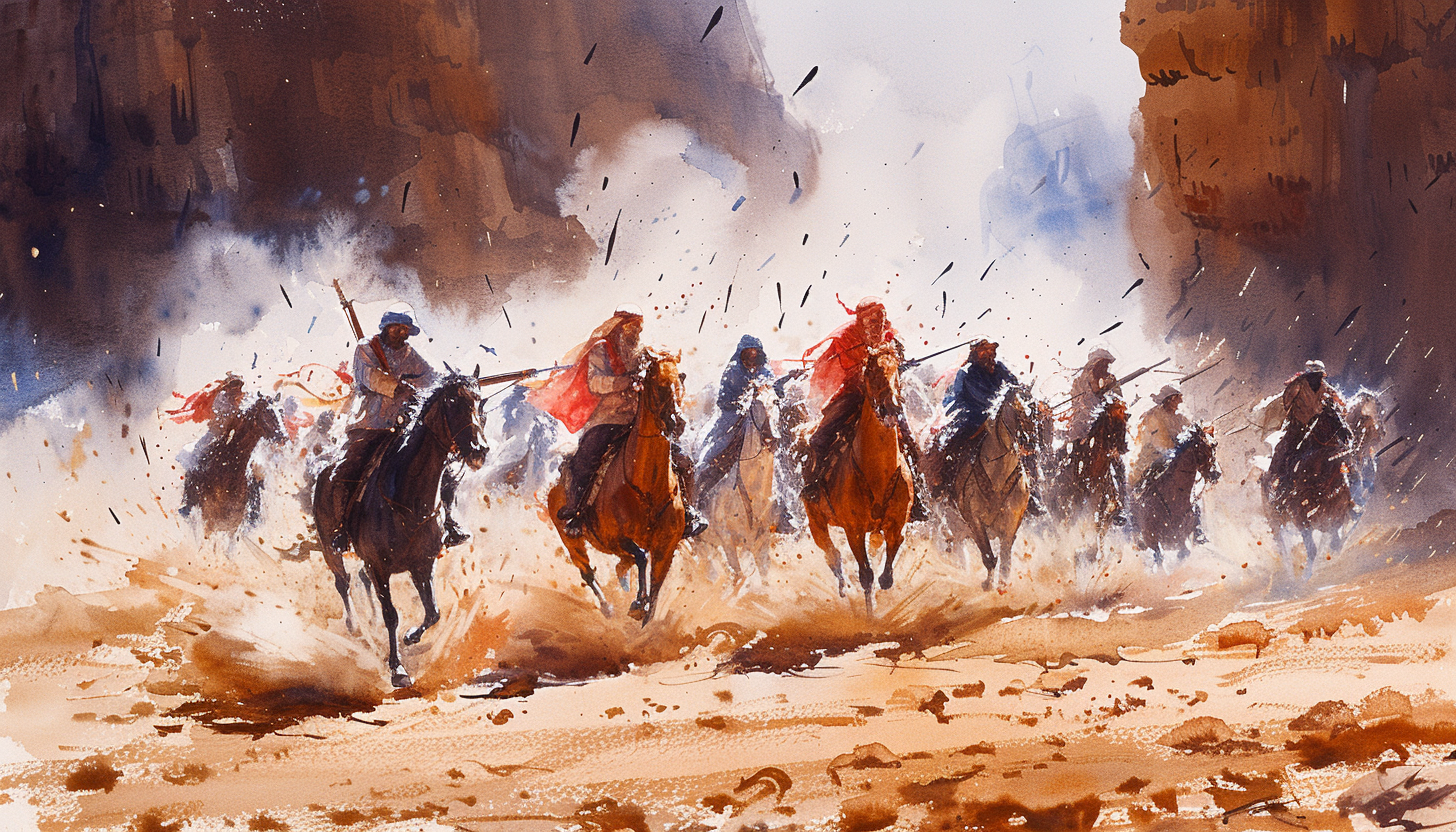In his seminal work “Arabia”, St. John Philby provides an intricate portrayal of his experiences and observations in early 20th century Saudi Arabia, shedding light on the cultural, political, and environmental landscapes of the region. Through his narrative, Philby unveils the complexities of life in the Wahhabi capital during the holy month of Ramdhan, offering insight into the trials and tribulations faced by its ruler and inhabitants. Philby navigates through a series of events involving key figures such as Ibn Sa’ud, the British Government, and the traditional enemies of the Wahhabi state, alongside the strategic dynamics at play in Central Arabia.
- Ibn Sa’ud faced a significant dilemma regarding a military campaign against Hail, highlighting his strategic and personal turmoil.
- The potential involvement of the British government added complexity to Ibn Sa’ud’s strategic decisions.
- Turki’s campaign against the Shammar highlighted the logistical challenges of desert warfare, leading to a strategic withdrawal.
- The Khurma Wahhabis’ successful defense against a Sharifian attack demonstrated their resilience and strategic capability.
- Ibn Sa’ud’s diplomatic stance and confidence in rallying support reflected his leadership strength and vision for the region.
- A picnic in the Hauta garden offered insights into Ibn Sa’ud’s societal interactions and personal beliefs, particularly regarding Christians and Jews.
The Atmosphere of Ramadan in Riyadh
During the sacred month of Ramdhan, the Wahhabi capital was enveloped in a palpable sense of unease and anticipation. Despite the physical and spiritual challenges posed by the fast, a more profound concern loomed over both the ruler and his subjects. A vague yet foreboding cloud of uncertainty hovered, marking a period fraught with internal conflict and external pressures. The fast offered a temporary reprieve for the monarch from the active engagement in a perilous military venture, one that he had pledged to undertake. Despite his stoic acceptance of the penance required, the ruler was tormented by a deep-seated anxiety, barely concealed during moments of extreme fatigue.
Ibn Sa’ud at a Crossroads
Ibn Sa’ud found himself at a critical juncture in his leadership. Committed by his own declarations yet wary of the inherent dangers, he faced the daunting task of navigating through a landscape riddled with political and military challenges. His decision to focus on the religious observance of Ramdhan, avoiding discussions about his future plans, mirrored the ostrich’s instinct to hide in the face of danger. This analogy highlighted his strategy to temporarily evade confronting the looming threats, maintaining a facade of indifference until action became inevitable. At this pivotal moment, Ibn Sa’ud’s leadership and the fate of the Wahhabi state teetered on the edge of significant change.
Even so is the ostrich, the feathered king of the desert, said to bury his head in the friendly sand in the presence of danger. Conscious of his strength and speed he seeks to evade the notice of the foe until the choice between fight and flight is forced on him.
St. John Philby: Arabia
Ibn Saud’s Dilemma
Ibn Sa’ud found himself at a decisive moment that demanded a choice with irreversible consequences. His contemplation centred around a bold, yet perilous strategy: launching an attack on Hail, the bastion of his traditional adversaries, the Rashids, who enjoyed the backing of the Turks. This was not merely a military campaign but a pivotal move that could potentially redefine the power dynamics in Central Arabia. The Rashids’ stronghold in Hail represented a significant threat to the stability and expansion of the Wahhabi domain, making the decision to attack a matter of strategic importance.
The straight road led to Hail, where the traditional enemy of his house still ruled unchallenged with the substantial support of the Turks. The elimination of Ibn Rashid would probably break forever the balance of power which made the position of the Wahhabi state so precarious in Central Arabia.
St. John Philby: Arabia
The Burden of Leadership and Strategic Hesitation
The essence of Ibn Sa’ud’s dilemma lay in the balance between the commitment to his word and the inherent risks of the enterprise. His hesitation was not born out of fear but a deep understanding of the complexities and unpredictable outcomes of such a venture. The decision to attack Hail was fraught with uncertainties, not least of which was the potential reaction of international powers and the complex interplay of regional alliances.
British Involvement
An intriguing aspect of Ibn Sa’ud’s contemplations was the potential involvement of the British government. Despite their official stance of maintaining the status quo in the desert’s power balance, there was an implicit understanding that British support might be forthcoming. This external support was not just a matter of military aid; it represented a significant diplomatic manoeuvre that could legitimise Ibn Sa’ud’s actions on the international stage and influence the wider geopolitical landscape of the Arabian Peninsula. The British, seeking to divert Wahhabi attention from other grievances, found themselves indirectly involved in the shaping of the region’s future through their complex relationship with Ibn Sa’ud.
Ibn Sa’ud could expect some measure of material support from the British Government, which, though in principle averse to any disturbance of the existing balance of power in the desert, sought some means of diverting Wahhabi attention from grievances against King Husain of the Hijaz and others, who happened to be our allies.
St. John Philby: Arabia
British-Protected Coastal Rivals
Ibn Sa’ud’s apprehension centred around the coastal entities under British protection. In his view, these rivals posed a more significant and enduring threat to the stability and autonomy of his rule than the traditional desert adversaries like Ibn Rashid. This perspective reveals Ibn Sa’ud’s deep-seated concern for sovereignty and the independence of his domain, which he perceived to be at risk from the encroachments of a global power. The British, with their naval dominance and a network of protectorates along the strategic coastal areas, represented a formidable challenge to regional leaders aspiring to consolidate their power without external interference.
Ibn Sa’ud felt that a rival in the desert was a minor menace in comparison with rivals on the coasts of the great sea, secure forever in their reliance on British protection…If he had been a free agent he would have preferred to direct his march against the Hijaz borders or against Kuwait, and, if he had acted on such an impulse, it is unlikely that he would ever have become more than the ruler of Wahhabi Arabia.
St. John Philby: Arabia

Early Campaign Moves
In the complex chess game of regional politics and military strategy that unfolded in the Arabian Peninsula, the early manoeuvres before the fasting month of Ramdhan marked the onset of a carefully orchestrated campaign. This initial phase of military operations was characterised by a bold move from Turki, the young heir to the Wahhabi throne. His foray into the Shammar frontiers was not merely a military expedition but a clear signal of the Wahhabi state’s intentions and the beginning of what promised to be a significant confrontation.
Turki Ibn Sa’ud’s Initiative
The decision by Turki to ride forth with a considerable force of Ikhwan (brotherhood) warriors into the territories of the Shammar tribe was a deliberate and provocative action. This move was calculated to test the waters and assert Wahhabi strength and resolve. It was a demonstration of the burgeoning military and political ambitions of the Wahhabi leadership, aimed at challenging the status quo and asserting dominance over their rivals.
The Reaction of Sa’ud Ibn Rashid
The response from the Shammar camp to this incursion was swift. Sa’ud Ibn Rashid, aware of the potential threat posed by the Wahhabi forces, made a strategic retreat to his capital. This move was a calculated decision to consolidate his position and prepare for the impending conflict. The arrival of his agent from Constantinople with a consignment of artillery and ammunition underscored the seriousness with which the Shammar leadership viewed the Wahhabi threat. It highlighted the broader regional dynamics at play, with the Ottoman Empire (represented by Constantinople) playing a role in the arming and support of its allies in the Arabian Peninsula.
Peace Negotiations and Blockade
As the early moves of the campaign unfolded, the political landscape was further complicated by rumours suggesting that Ibn Rashid was seeking peace negotiations with the British authorities. This manoeuvre was interpreted as an attempt to mitigate the hardships imposed by a strategic blockade that had begun to strain resources in Hail and its surrounding tribal territories. Despite occasional breaches in the blockade, the situation for Ibn Rashid and his constituents was becoming increasingly untenable, prompting speculation about his intentions towards securing a more sustainable resolution.
On the whole it is probable that these peace-feelers on the part of various Shammar chieftains were occasioned less by any genuine desire for peace than by the wish to secure supplies to pass on to Damascus and other places where very considerable profits were to be made at this time.
St. John Philby: Arabia
Ibn Sa’ud’s Response
In the face of these developments, Ibn Sa’ud maintained a firm stance on the continuation of hostilities against Ibn Rashid, as long as the latter remained in alliance with the Turkish forces. This position underscores Ibn Sa’ud’s strategic priorities, emphasising the importance of weakening the Turkish influence in the region while remaining open to the possibility of reconciliation. Ibn Sa’ud’s willingness to entertain peace, provided Ibn Rashid would explicitly express a desire for it, either directly or through British intermediation, reveals a pragmatic approach to conflict resolution. It reflects a broader understanding of the fluid dynamics of regional power struggles and the potential benefits of shifting from confrontation to diplomacy under the right conditions.
Turki’s Campaign and Strategic Withdrawal
The military operations initiated by Turki, the heir to the Wahhabi throne, against the Shammar frontiers marked a significant early move in the broader strategic landscape that Philby describes. However, this ambitious campaign encountered immediate logistical challenges that significantly hindered its progress. These difficulties primarily revolved around the procurement and management of water resources, a critical factor in the desert warfare that characterises the Arabian Peninsula. The campaign’s aim to harry the Shammar frontier, a preemptive move to weaken Ibn Rashid’s position, quickly faced the harsh realities of military logistics in arid environments.
Logistical Dilemma and Its Implications
Upon reaching the watering place of Bashuk, Turki and his forces found it deserted and the wells insufficient to meet the needs of his contingent. This discovery underscored the strategic importance of securing reliable water sources for any sustained military operation in the desert. The proposal to advance to the wells of Umm al Radhma highlighted the dire situation, with advisors cautioning against further movement due to the anticipated lack of water.
Turki had followed them in the direction of the road from Hail to Lina and, arriving at the watering of Bashuk, found the place deserted and the wells insufficient for the needs of his force. He was personally for going on to the wells of Umm al Radhma, a day’s march to the north-east, but Ibn Musaiyis, chief of the Mutair contingent, had warned him that neither there nor at Hidaqa to the eastward would he find sufficient water and, after a heated argument, had prevailed on him to retire to ’Ajba.
St. John Philby: Arabia

Strategic Withdrawal to Qasim
The culmination of these logistical challenges led to a strategic withdrawal. Turki’s decision to retire to ‘Ajba, and subsequently to adopt a defensive posture in the Qasim region, represented a significant shift from offensive to defensive strategy. This change in tactics was not merely a reaction to immediate logistical setbacks but a calculated move to preserve the fighting capability of his forces in the face of uncertain water supply and the potential for overextension.
Tensions on the Hijaz Frontier
As the campaign under Turki’s leadership encountered logistical setbacks leading to a strategic withdrawal, tensions elsewhere, specifically on the Hejaz frontier, presented Ibn Sa’ud with another layer of complexity in his strategic calculations. Philby highlights how Ibn Sa’ud’s response to emerging threats and calls for assistance from the Hijaz region was marked by a cautious approach, driven by a keen awareness of the potential for escalation with Sharifian forces.
Cautious Diplomacy Amidst Rising Tensions
Ibn Sa’ud’s cautious reply to Khalid Ibn Luwai, the Amir of Khurma, who anticipated an attack by Sharifian forces, underscores the delicate balance Ibn Sa’ud sought to maintain. While he did not dismiss the concerns of his ally, his counsel was marked by an emphasis on prudence and restraint. This response was indicative of Ibn Sa’ud’s broader strategy to avoid direct confrontation that could escalate into a larger conflict with the Sharifian forces, potentially drawing in international attention and complicating regional dynamics.
Strategic Restraint and Tactical Adjustments
The decision to divert military resources, such as the Ghatghat contingent of ‘Ataiba Ikhwan, which had initially been mobilised to support Khurma, to Turki’s concentration in Qasim, further demonstrates Ibn Sa’ud’s commitment to a defensive posture. This move only reflected a strategic prioritisation of resources and a tactical adjustment to the evolving security situation. By reinforcing his positions in Qasim, Ibn Sa’ud aimed to consolidate his strength, maintaining a stance that could deter aggression without provoking unnecessary conflict.
A Defensive Victory
The response of the Khurma Wahhabis to the Sharifian assault was both swift and decisive. Despite the suddenness of the attack, which was heralded by a salvo of artillery fire, the defenders managed to recover quickly from their initial surprise. The ensuing counterattack by the Khurma Wahhabis not only repulsed the Sharifian forces but also inflicted significant casualties, capturing critical weapons in the process. This victory, marked by the seizure of enemy guns and machine guns, was a testament to the fighting spirit and tactical acumen of Ibn Sa’ud’s allies. It underscored their capability to not only withstand Sharifian aggression but to turn the tide of battle in their favour.
There was every danger that the Ikhwan, flushed with an initial victory, might collect reinforcements and assume the offensive, in which case the whole border from Tathlith northwards would soon be aflame. On the other hand it was not unlikely that the Sharif, smarting under the ignominy of such a defeat, would try to avenge it with larger forces, in which case Ibn Sa’ud could scarcely hope to prevent all the Ikhwan elements of Najd from flocking to the assistance of their brethren in the faith.
St. John Philby: Arabia
Philby’s account of this engagement highlights the critical role of localised conflicts in shaping the larger struggle for supremacy in the Arabian Peninsula. The Khurma Wahhabis’ ability to repel a Sharifian attack not only marked a significant success for Ibn Sa’ud’s coalition but also illustrated the challenges of projecting power and maintaining control in a region characterised by shifting allegiances and the harsh realities of desert warfare.
Ibn Sa’ud’s Diplomacy and Vision
In the midst of military campaigns and strategic manoeuvres, Ibn Sa’ud’s diplomatic acumen and long-term vision for his leadership and the region’s future come to the forefront. Philby’s narrative provides a glimpse into Ibn Sa’ud’s perspective on the broader geopolitical shifts, particularly his views on British negotiations with the Sharif of Mecca. Despite the tumultuous and uncertain environment, Ibn Sa’ud displayed a remarkable confidence in his ability to mobilise support across the Arabian Peninsula, a testament to his leadership and the loyalty he commanded among his followers.
He was in fact in high good humour, and discoursed at some length on the initial mistake the British Government had made in negotiating with the Sharif.‘ Some day,’ he said, ‘ you will bitterly regret your mistaken policy. I have no desire to interfere in the affairs of the Hijaz, but you should know I have but to give the word and a great host would flock to my banner from all parts — from Bisha and Najran, from Ranya and Tathlith and elsewhere.
St. John Philby: Arabia
Confidence in Support
Ibn Sa’ud’s assertion that he could rally a significant force from across the region “from Bisha and Najran, from Ranya and Tathlith and elsewhere” underscores his influence and the widespread support he enjoyed. This confidence reflected a deep understanding of the tribal dynamics and the respect he garnered as a leader capable of uniting various factions under a common cause. His belief in the superiority of death over life for the promise of eternal reward reveals the depth of conviction and the ideological fervor that he could inspire in his followers, a critical component of his leadership.
And not one of them but is convinced that death is better than life, not one but lives to die for the great reward, and every one of them convinced that to turn back or hesitate is but to court the certainty of hell-fire.’
St. John Philby: Arabia
Disdain for Sharifian Leadership
Further revealing his diplomatic stance, Ibn Sa’ud did not mince words when it came to his opinion of the Sharifian leadership. His candid expression of disdain for the Sharif and Abdullah as “khasis—a poisonous fellow” not only highlights his personal animosity but also reflects the deep-seated rivalries that shaped the political landscape of the Arabian Peninsula. These comments reveal a leader who, while open to negotiation and diplomacy, remained fiercely protective of his realm’s interests and sceptical of the motivations and character of his adversaries.
He fully realised that an outburst of hostilities between himself and his rival would be fatal to the interests of all concerned, though there was little doubt that Husain desired to provoke him to an open breach of the peace in order to force the hand of Great Britain.
St. John Philby: Arabia
A Vision Beyond Confrontation
Despite the immediate concerns of military engagements and political alliances, Ibn Sa’ud’s reflections to Philby reveal a leader looking beyond the horizon of current conflicts. His critique of British negotiations with the Sharif hints at a broader vision for the region, one where the intricacies of tribal allegiance, international diplomacy, and ideological commitment intersect. Ibn Sa’ud’s ability to articulate a clear stance on these matters, coupled with his strategic and diplomatic maneuvering, underscores his role as a pivotal figure in shaping the destiny of the Arabian Peninsula.
Cultural and Personal Insights
In a departure from the intense discussions of military campaigns and political strategies, Philby offers a rare glimpse into the societal interactions and personal preferences of Ibn Sa’ud through the lens of a leisurely picnic in the Hauta garden. This anecdote serves not only to humanise the ruler, presenting him in a more relaxed and personal setting, but also to shed light on his views towards other religions, which played a significant role in his leadership and the ideological foundation of the Wahhabi state.
Views on Christians and Jews
Perhaps most revealing during this gathering were Ibn Sa’ud’s expressed opinions on Christians and Jews, which illuminate his complex worldview. His willingness to marry a Christian woman, under the condition that any offspring would be raised Muslim, juxtaposed with his refusal to marry from among the “Mushrikin“, including Muslims he deemed to be associating others in worship with God, highlights a nuanced approach to interfaith relations. His respect for “people of a book” and his candid, albeit critical, views on Jews reflect the ideological and religious underpinnings that influenced his governance and his interactions with foreign powers.
He then seized the opportunity of launching out into one of his favourite themes — the comparative merits of Christians and non-Wahhabi Muslims lumped together in the category of Mushrikin. ‘ Why ! he said, ‘if you English were to offer me of your daughters to wife I would accept her, making only the condition that any children resulting from the marriage should be Muslims. But I would not take of the daughters of the Sharif or of the people of Mecca or other Muslims, whom we reckon as Mushrikin. I would eat of meat slain by the Christians without question. Ay, but it is the Mushrik, he who associates others in worship with God, that is our abomination.
St. John Philby: Arabia

Through Philby’s account, we gain insight into the complex character of Ibn Sa’ud—a leader who navigated the treacherous waters of regional politics with a blend of military prowess, diplomatic strategy, and unwavering vision. His reflections on the challenges and opportunities of his time provide a valuable perspective on the historical forces that shaped the modern Middle East.
FAQ
Q: What was the significance of the Ramdhan period for Ibn Sa’ud?
A: It was a time of unease and reflection on his commitment to a dangerous enterprise.
Q: Why did Ibn Sa’ud hesitate in his campaign against Hail?
A: He was concerned about the risks and the potential for altering regional power dynamics.
Q: How did the British government factor into Ibn Sa’ud’s plans?
A: Their potential support added complexity to his decisions, despite their official stance of neutrality.
Q: What challenges did Turki’s campaign face?
A: Logistical issues, particularly securing water sources, led to a premature end.
Q: Were there any attempts at peace negotiations with Ibn Rashid?
A: Yes, rumors suggested Ibn Rashid sought peace to alleviate the hardships of a blockade.
Q: How did Ibn Sa’ud view the Sharifian leadership?
A: He expressed disdain for the Sharif and considered the leadership poisonous.
Q: What does the picnic in the Hauta garden reveal about Ibn Sa’ud?
A: It showed his societal interactions and personal opinions on religious groups, revealing a multifaceted leader.

